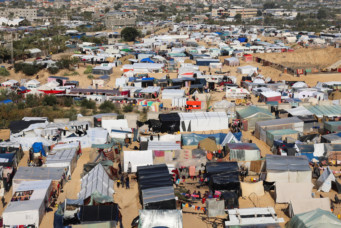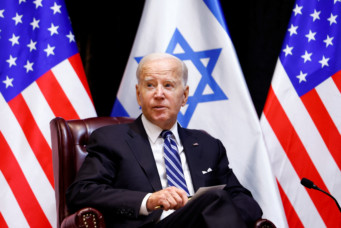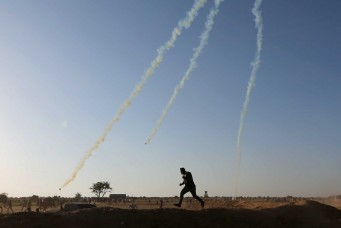Children’s “Right to Play” In Gaza
Like children everywhere, Gaza’s boys and girls should be playing and enjoying their childhoods, but the actions of the Israeli government and military make that impossible

June 11, 2024 marked the first annual International Day of Play (IDOP). While the day was established by a United Nations General Assembly resolution in March 2024, the campaign for the International Day of Play was initiated by the LEGO Group and LEGO Foundation and coordinated by a network of organizations. The Children and Young People’s Call to Action defines play as “our right to have fun and express ourselves freely through different activities and sports. Play is not just for fun; it is essential. It helps us be creative, learn new things, and make friends. Playing makes us feel good and helps us grow up healthy and happy, both in our bodies and our minds.”
The Call to Action, drafted by The Child and Youth Advisory Board, also includes findings from online surveys and focus group discussions looking at the impact of play—and lack thereof—from over 10,000 children and young people around the world. The consequences of loss of play include negative impacts on the physical and mental health of children and young people. These consequences are more prevalent than ever, the Call to Action reports.
It has found that “27 percent of children play outside their homes today, a stark contrast to the 71 percent of our parents and grandparents”. Barriers to play are particularly high for children with disabilities, girls, children living in areas that hold play as less culturally important, and children living in areas that lack safe play spaces due to natural disaster and war, such as in the Gaza Strip.
The loss of play during warfare may seem trivial compared to the catastrophic harm inflicted by Israel on Gazan children, families, and communities. Casualties in Gaza as of June 9, 2024 include 37,084 killed, including over 15,000 children, 84,494 injured, and over 10,000 missing. Since October 7, over half of Gaza’s homes had been destroyed or damaged, as well as 88 percent of school buildings, and 267 places of worship. Hospitals, medical facilities, and medical workers across the Gaza strip have been specifically targeted, destroying the Gazan healthcare system. At least thirty children in Gaza have died as a result of malnutrition, with famine continuing to unfold across Gaza under Israel’s forced starvation policies.
The current onslaught of violence by Israel against Palestinians in Gaza comes despite orders from the International Court of Justice (ICJ) to take steps to limit harm to Palestinians and avoid committing genocide, as well as to immediately halt military operations in Rafah. Far from complying with the ICJ’s orders to adhere to the Genocide Convention, Israel’s military attacks and denials of humanitarian aid have only increased, leading International Criminal Court Prosecutor Karim A.A. Khan KC to seek arrest warrants against Israeli Prime Minister Benjamin Netanyahu and Israeli Minister of Defence Yoav Gallant for war crimes and crimes against humanity, in addition to seeking warrants against three Hamas leaders.
According to Al Jazeera, casualties from October 7 to June 9 also include 1,139 people killed in Israel and some 8,730 injured, as well as 532 people killed and over 5,000 injured in the West Bank. Casualties in the occupied West Bank are expected to grow as it faces what the UN human rights chief calls “unprecedented bloodshed” associated with attacks by Israeli military and settlers against Palestinians. Israel—along with Hamas and the Palestinian Islamic Jihad—is being added to the annex of the UN’s next annual report on children in armed conflict, also known as the “blacklist” of parties that commit grave violations against children.
The current war comes amidst the backdrop of decades of occupation, displacement, and oppression by Israel against the Palestinian people. And yet, in the face of all of this, children in Gaza have a right and a need to play.
What is the “Right to Play”?
Article 31 of the Convention on the Rights of the Child (CRC) says: “States Parties recognize the right of the child to rest and leisure, to engage in play and recreational activities appropriate to the age of the child and to participate freely in cultural life and the arts.” Adopted by the UN General Assembly in 1989, the CRC is the most widely ratified human rights treaty in the world, and all States Parties have an obligation to uphold Article 31’s right to play. The United States is the only UN Member State that is not Party to the convention, though it is signatory and is therefore obligated to refrain from actions that would contradict the object and purpose of the treaty. As a legally binding human rights treaty, the CRC is applicable in both times of peace and war and it primarily refers to how a government must treat its citizens.
The CRC is the culmination of decades of advocacy, with international declarations on the rights of the child previously adopted by the League of Nations in 1924 and the United Nations in 1959. These two previous non-binding declarations say a child must have “the means requisite for its normal development, both materially and spiritually” and the “full opportunity for play and recreation,” respectively. In 1978, Poland proposed a legally binding Convention on the Rights of the Child, which was then developed by a working group created by the Commission on Human Rights in 1979—the Year of the Child. Ten years later, the CRC was adopted, but Article 31’s right to play received little focus, especially regarding children impacted by armed conflict.
In 1996, the landmark Graça Machel report, Impact of Armed Conflict on Children, was released, centering children as the primary victims of armed conflict. The only mention of play in the report is as a strategy to promote psychosocial well-being through re-establishing a sense of normalcy. The ten-year-review of the Machel report put greater focus on the importance of play, discussing its importance as an early childhood intervention, its connection to education, and its loss as a significant consequence of war. The review contains quotes from a child in Somalia about how their playgrounds were transformed into centers of military mobilization, as well as a girl who said of her Sri Lanka transit center, “There are no trees to play under and no playground to go to”. Increasingly, organizations focused on child welfare have recognized the importance of play in psychosocial resilience and healing, prompted by the voices of children themselves.
In 2014, War Child Holland released a “Child Rights Situation Analysis” on Syria, which found play to be “one of the top five priorities by 50 percent of child participants”. As studies of the relationship between war and play have grown, it has become increasingly clear that play is simultaneously one of the first things lost in war and one of the most important factors for mitigating its psychosocial harms.
Persistent threats lead to a toxic stress response, which has long term impacts on developing bodies and minds. Play offers some protection by lowering the need for stress response. Children may also augment play to reflect the violence that they see around them, a form of processing and communicating their complicated emotions and traumas. Wartime has necessitated creative ways to play, such as the underground amusement park near Damascus, which gave Syrian children a space to play away from the bombs. The park gave children a break from the constant fear of war, with one child expressing, “I’m not afraid of bombardments because my father told me that we are in the basement”.
While war presents clear obstacles to play, or at least play as it is experienced in peace time, children experiencing war-related trauma need play more than ever. Play is a protective factor to boost a child’s resilience, especially as their minds and bodies are developing. It can help to distract children, to work through their experiences, and to preserve memories of the past and hopes for the future. In Gaza, play—in addition to basic necessities, cultural heritage, and survival—is under attack by the Israeli military.
Playing in Gaza
Like in previous conflicts, children in Gaza are finding ways to play, sometimes through organizations and the leadership of community members and sometimes through their own creativity. One such organization is Hope Makers School, which seeks to provide education for children in the al-Mawasi displacement camp. Schools across Gaza have been destroyed or transformed into shelters for displaced people, leaving no functioning schools across all of Gaza and over 600,000 students without education for the past eight months. The director of Hope Makers School, Ashraf Asfour, explained that they focus on three study areas: psychological care, values and principles, and education and skills. In addition to learning Arabic and math, children are able to participate in art classes. One student says, “I also learned how to draw a fruit basket because I like fruit so much. I haven’t had any fruit for three weeks”.
Providing students with a safe place to learn and express themselves through creativity is of the utmost importance. UNICEF spokesperson Ricardo Pires told Al Jazeera: “We can say safely that every single child in the Gaza Strip today is traumatized… every single teacher is now indeed a social worker, a parent.” This is especially true for the over 20,000 children who have been orphaned in the war. Further attempts at continuing education for children in Gaza and providing them a safe place to play have been taken up by people like Nur Nassar on Instagram, who travels with a whiteboard and educational materials in a #School_Without_Borders. The Instagram account’s Reels show children excitedly participating in lessons, contributing to group art projects, and playing educational games.
Play in Gaza is additionally used as a form of cultural preservation. A weekly art workshop sponsored by the UK charity Christian Aid and run by Palestinian partner the Culture and Free Thought Association allows children to draw and color their memories of bombed historical buildings such as Qasr al-Basha and Omari Mosque. Buthaina al-Fuqawi, a community mobilizer who helps run the sessions, observed of the participating children: “The first look is despair and misery. The second look is hope. The third look is love of life and childhood.” For many children, the workshops are the first time they’ve been able to use a pencil or crayon in months. The workshops serve the dual purpose of briefly distracting children from their hardships and also helping to preserve Palestinian cultural heritage, which has been severely impacted by the ongoing conflict.
Additional efforts to preserve play and heritage have been made by the Asayel Arts and Dabke Troupe, which was established in 2011 and now gives dance classes to displaced children in Deir el-Balah. Dabke is a Palestinian dance usually accompanied by traditional wind instruments and singing in local dialects. The children interviewed by Al Jazeera say that learning the dance has helped distract them from the ongoing war, with one participant sharing: “It fills me with joy, by the way. Ever since I was younger, I would dream of knowing how to dance dabke.” Another participant reflects, “I do enjoy it, but there isn’t a greater joy than going back home”.
Children have also taken it upon themselves to create opportunities for play while they are away from home. A video shared by @middleeastmonitor and @samih.madhoun on Instagram shows a young musician, Samih Madhoun, playing the oud and singing to other children and displaced people in Gaza. Before the war, Samih had been building his name as a musician in Gaza City. As of early June, Samih’s family is facing their sixth displacement since October 2023.
Other children, like @renadfromgaza have also taken to social media to spread awareness of Gaza and the needs of their families, while also sharing their own creativity and talents. Renad, ten years old, posts videos on Instagram and TikTok of her cooking “Gazan styled” dishes from a displacement camp. Some of her dishes include “war’s lollipop,” made from melted sugar, and “war falafel,” a video that couldn’t be finished because Renad and her family received news of a “relative’s martyrdom”. Renad’s Instagram bio reads “Struggling to survive and live my childhood”.
For many children, living their childhood is no longer an option. In January, NBC News covered the story of thirteen-year-old Mohammad Al Yazji and his seven younger siblings. After their mother was killed by an Israeli strike just days into the war and their father went missing, Mohammad became the sole caretaker of the family. Every morning, he wakes up at six to get his siblings food and water. He expresses particular sadness about caring for his six-month-old sister, especially with a scarcity of baby formula and diapers caused by Israeli blocking of aid and supplies: “[My mother] knew how to silence her when she cried. I don’t know how to deal with this.” Still, Mohammad recognizes the need of his siblings for play. With the small amount of money he gets from aid groups, Mohammad buys his siblings a ball to play with “so they forget the war and do not get bored”. Still, Mohammad shares that his siblings cry whenever they hear an air strike.“There is no one to give them a feeling of safety,” he says.
While children are finding creative ways to play, distract themselves from the war, and preserve their cultural heritage, there is no replacement for feeling safe enough to experience a normal childhood. When one young girl, Lina, asks her father what they will do when they go back home, he replies, “Life will go back to how it used to be. We’ll go to the park. Play with everyone”. The video, published by The Guardian in November 2023, shows Lina and other children playing hopscotch in the sand and then playing “the shooting game” in the back of a truck, in which the “shooter” must choose another player to kill every round. Lina’s games demonstrate the use of play as distraction, as emotional processing, and as something which can only be fully realized in a safe future.
Lost Childhoods
In March 2024, Save the Children released a report entitled “Trapped and Scarred: The Compounding Mental Harm Inflicted On Palestinian Children in Gaza”. The report underscores the fact that Palestinian children currently displaced in Gaza have never lived “outside of interminable cyclical violence and a life-limiting land, air and sea blockade imposed by the Government of Israel”. While the mental health and rights of children were already undermined by the almost seventeen-year blockade on Gaza, parents and caregivers report that the current war has made the situation unimaginably dire.
Children are experiencing a “destruction of the fundamental tenets of childhood… no escape from the reality of war, no stable routine, no opportunity to learn or play—and for many, no family”. It is routines, playing, learning, and family that are usually protective factors against long-term and severe mental health impacts of trauma, leaving many children in Gaza defenseless. One mother of four told Save the Children: “I wouldn’t even say that their mental health has deteriorated—it’s been obliterated. Complete psychological destruction.” Similarly, spokesperson for UNICEF James Elder told Al Jazeera, “children are in uncharted territory, psychologically… I see children in those tents…who have had amputations, who need to be in hospital both for their physical wounds, but also psychologically”. As more hospitals across Gaza are bombed, shut down, and denied basic supplies by Israeli attacks and Israel’s closure of all crossings out of Gaza, this type of medical assistance becomes impossible.
Though some children and communities have found or made opportunities for play and fun, the definition of a fully realized right to play by the Child and Youth Advisory Board in their Call to Action includes a kind of play that “helps us grow up healthy and happy, both in our bodies and our minds”. In Gaza, children should be playing and enjoying their childhoods, but the actions of the Israeli government and military make that impossible.
Instead, children are decapitated and burned while playing at a park like Ahmed Al-Najjar; they are left alone in a car surrounded by corpses as paramedics fight to get to them like Hind Rajab; and they are denied medical treatment and starve to death like Fayez Ataya and Abdulqader Al-Serhi. There is currently no way to “grow up healthy and happy” in Gaza, as UNICEF reports that every single child in Gaza has been exposed to traumatic experiences that will have life-long impacts. All the barriers to play discussed in the IDOP Call to Action are heightened in Gaza: disability rates have skyrocketed during the war as over 3,000 children have become amputees, young girls face increased risk of gender-based violence, the importance of play is secondary to physical integrity, and there are no safe places for play anywhere in Gaza.
As one nine-year-old child in Rafah, Adil, told Children in Conflict, “I used to laugh a lot… We as children, are living a life that isn’t good… It’s dark”.




